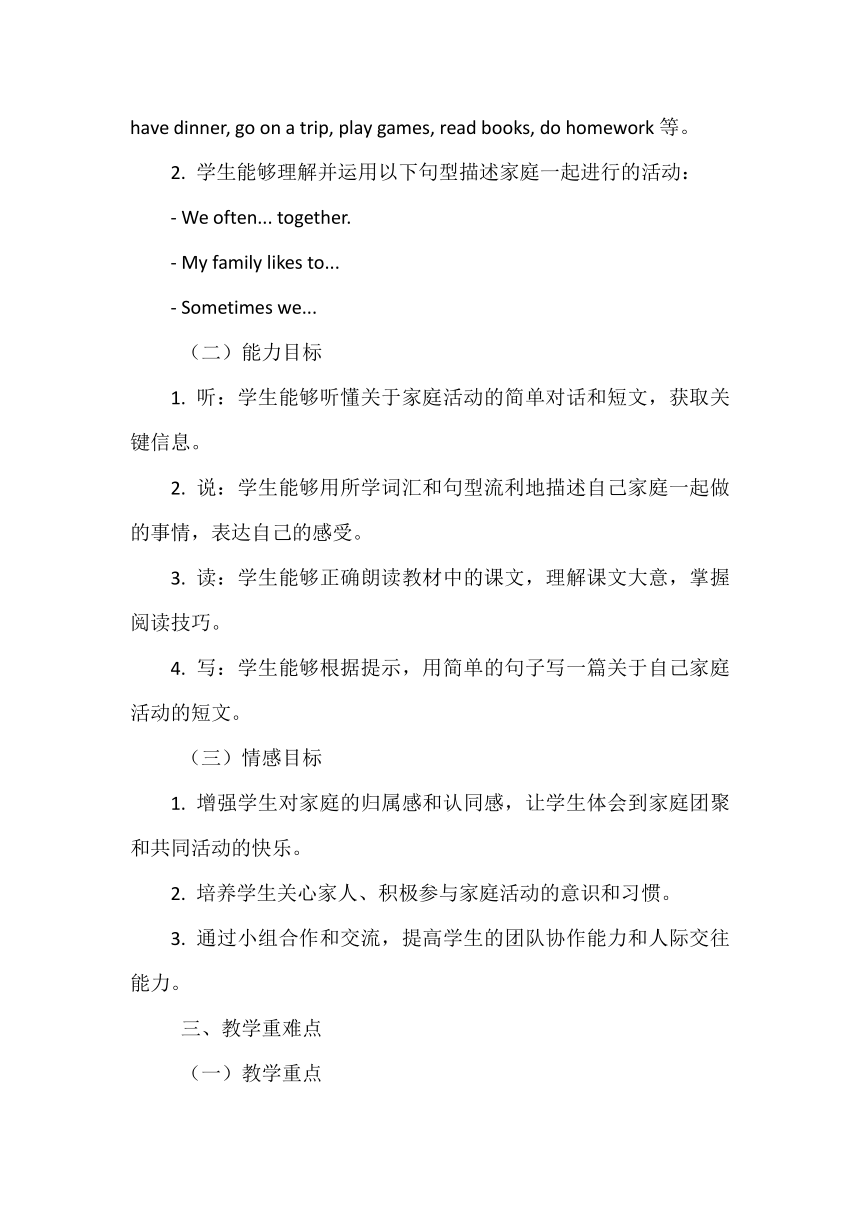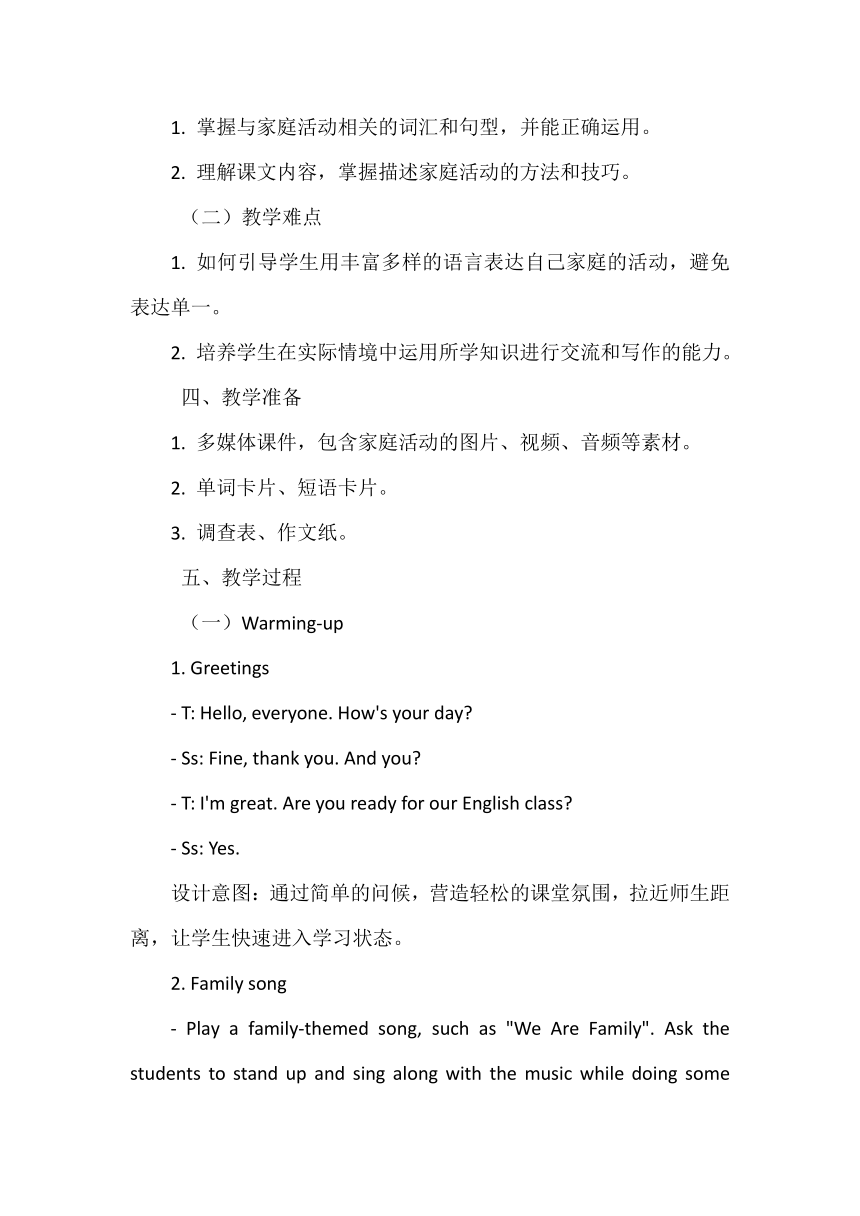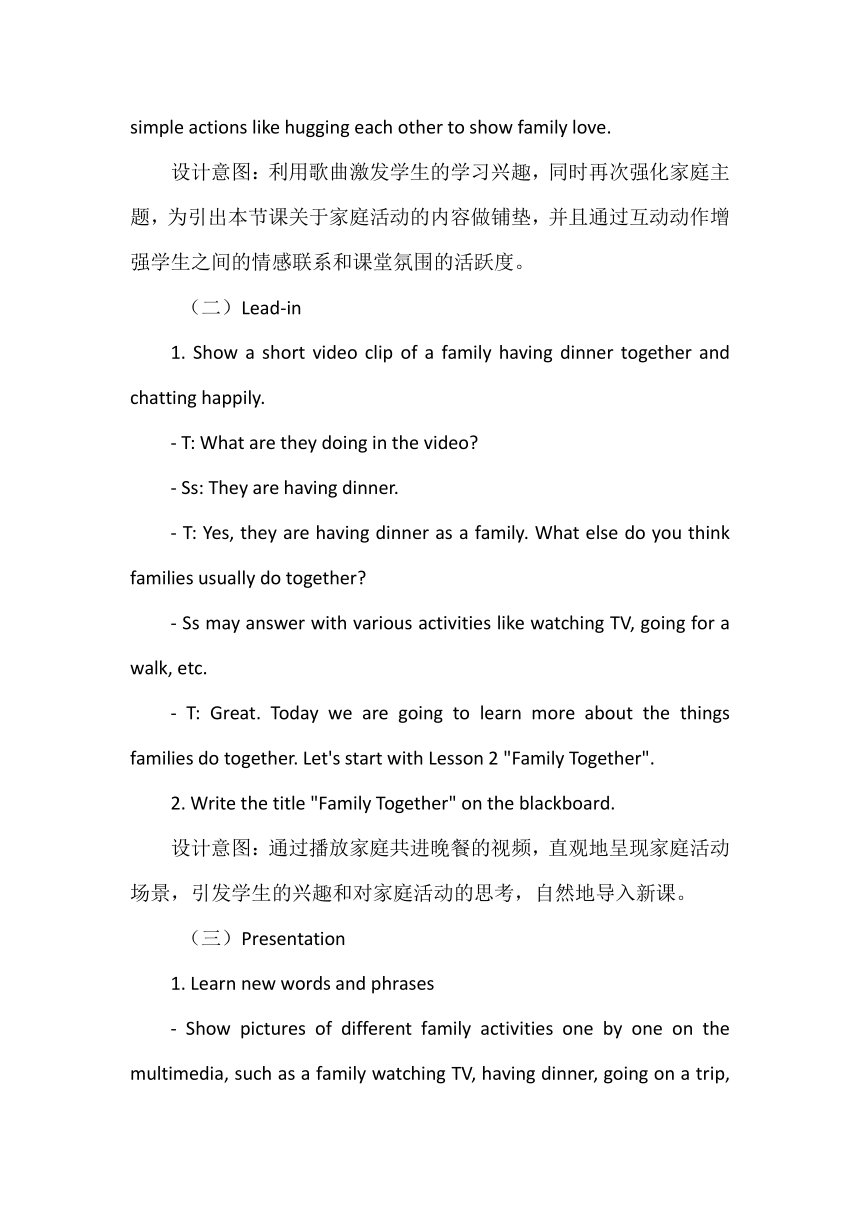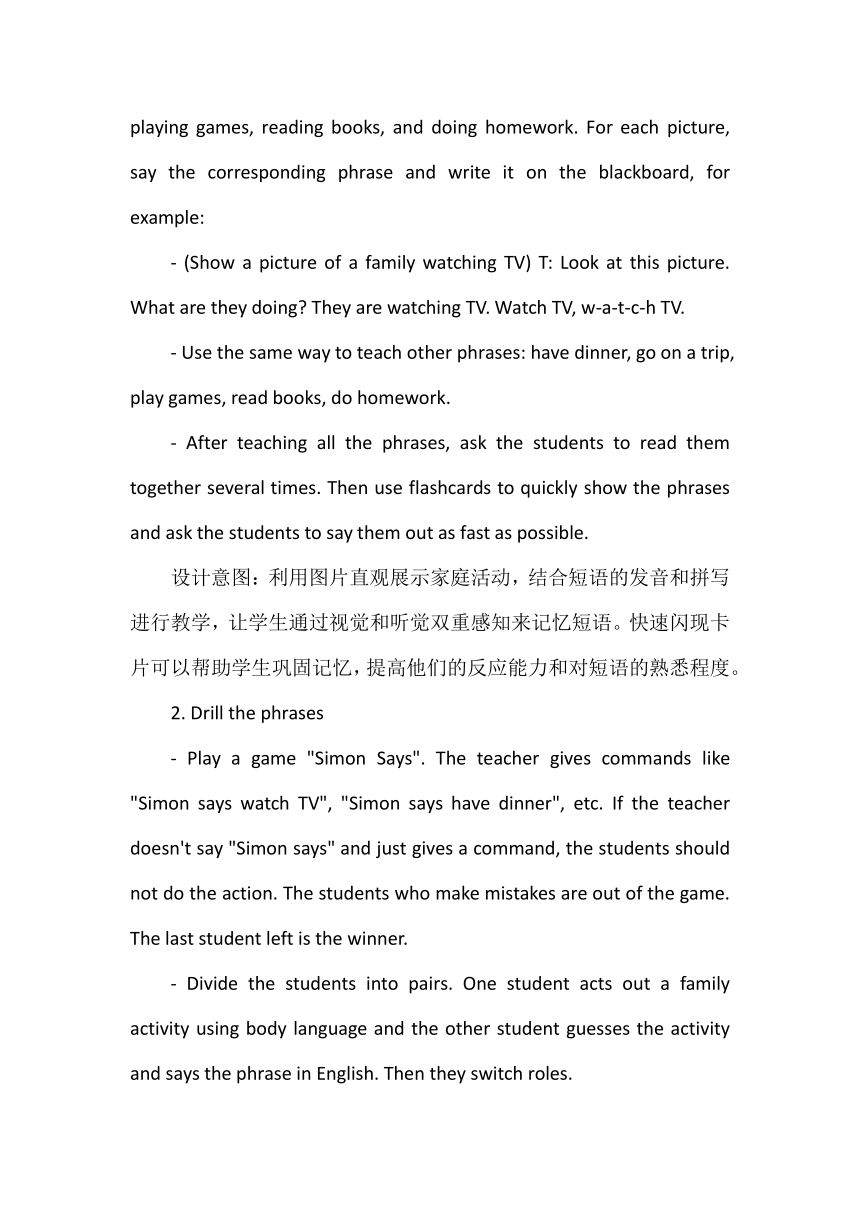北师大版(2024)七年级上册Unit 1 Family Lesson 2 Family Together 教学设计
文档属性
| 名称 | 北师大版(2024)七年级上册Unit 1 Family Lesson 2 Family Together 教学设计 |  | |
| 格式 | docx | ||
| 文件大小 | 25.6KB | ||
| 资源类型 | 教案 | ||
| 版本资源 | 北师大版 | ||
| 科目 | 英语 | ||
| 更新时间 | 2024-10-03 14:43:18 | ||
图片预览





文档简介
《Family Together》(教学设计)-2024-2025学年北师大版(2024)初中英语七年级上册
课题:Lesson 2《Family Together》
科目:初中英语
年级:七年级上册
版本:北师大版(2024)
课时安排:1课时
一、教材分析
《Family Together》是新教材北师大版(2024)初中英语七年级上册Unit 1《Family》中的Lesson 2的课时内容。在“Family”这一主题单元中,Lesson 2延续了对家庭的探讨,重点聚焦于家庭成员一起参与的活动以及家庭团聚的场景。通过描述家庭共同活动,如看电视、吃饭、旅行等,引导学生进一步感受家庭的温暖和亲情的重要性。教材内容不仅有助于学生巩固与家庭成员相关的词汇和句型,还能拓展学生对家庭生活场景的语言表达能力,培养学生对家庭的热爱和珍惜之情。同时,课文中的对话和短文为学生提供了真实的语言情境,有利于学生提高听力、口语、阅读和写作等综合语言运用能力。
二、教学目标
(一)知识目标
1. 学生能够掌握与家庭活动相关的词汇和短语,如:watch TV, have dinner, go on a trip, play games, read books, do homework等。
2. 学生能够理解并运用以下句型描述家庭一起进行的活动:
- We often... together.
- My family likes to...
- Sometimes we...
(二)能力目标
1. 听:学生能够听懂关于家庭活动的简单对话和短文,获取关键信息。
2. 说:学生能够用所学词汇和句型流利地描述自己家庭一起做的事情,表达自己的感受。
3. 读:学生能够正确朗读教材中的课文,理解课文大意,掌握阅读技巧。
4. 写:学生能够根据提示,用简单的句子写一篇关于自己家庭活动的短文。
(三)情感目标
1. 增强学生对家庭的归属感和认同感,让学生体会到家庭团聚和共同活动的快乐。
2. 培养学生关心家人、积极参与家庭活动的意识和习惯。
3. 通过小组合作和交流,提高学生的团队协作能力和人际交往能力。
三、教学重难点
(一)教学重点
1. 掌握与家庭活动相关的词汇和句型,并能正确运用。
2. 理解课文内容,掌握描述家庭活动的方法和技巧。
(二)教学难点
1. 如何引导学生用丰富多样的语言表达自己家庭的活动,避免表达单一。
2. 培养学生在实际情境中运用所学知识进行交流和写作的能力。
四、教学准备
1. 多媒体课件,包含家庭活动的图片、视频、音频等素材。
2. 单词卡片、短语卡片。
3. 调查表、作文纸。
五、教学过程
(一)Warming-up
1. Greetings
- T: Hello, everyone. How's your day
- Ss: Fine, thank you. And you
- T: I'm great. Are you ready for our English class
- Ss: Yes.
设计意图:通过简单的问候,营造轻松的课堂氛围,拉近师生距离,让学生快速进入学习状态。
2. Family song
- Play a family-themed song, such as "We Are Family". Ask the students to stand up and sing along with the music while doing some simple actions like hugging each other to show family love.
设计意图:利用歌曲激发学生的学习兴趣,同时再次强化家庭主题,为引出本节课关于家庭活动的内容做铺垫,并且通过互动动作增强学生之间的情感联系和课堂氛围的活跃度。
(二)Lead-in
1. Show a short video clip of a family having dinner together and chatting happily.
- T: What are they doing in the video
- Ss: They are having dinner.
- T: Yes, they are having dinner as a family. What else do you think families usually do together
- Ss may answer with various activities like watching TV, going for a walk, etc.
- T: Great. Today we are going to learn more about the things families do together. Let's start with Lesson 2 "Family Together".
2. Write the title "Family Together" on the blackboard.
设计意图:通过播放家庭共进晚餐的视频,直观地呈现家庭活动场景,引发学生的兴趣和对家庭活动的思考,自然地导入新课。
(三)Presentation
1. Learn new words and phrases
- Show pictures of different family activities one by one on the multimedia, such as a family watching TV, having dinner, going on a trip, playing games, reading books, and doing homework. For each picture, say the corresponding phrase and write it on the blackboard, for example:
- (Show a picture of a family watching TV) T: Look at this picture. What are they doing They are watching TV. Watch TV, w-a-t-c-h TV.
- Use the same way to teach other phrases: have dinner, go on a trip, play games, read books, do homework.
- After teaching all the phrases, ask the students to read them together several times. Then use flashcards to quickly show the phrases and ask the students to say them out as fast as possible.
设计意图:利用图片直观展示家庭活动,结合短语的发音和拼写进行教学,让学生通过视觉和听觉双重感知来记忆短语。快速闪现卡片可以帮助学生巩固记忆,提高他们的反应能力和对短语的熟悉程度。
2. Drill the phrases
- Play a game "Simon Says". The teacher gives commands like "Simon says watch TV", "Simon says have dinner", etc. If the teacher doesn't say "Simon says" and just gives a command, the students should not do the action. The students who make mistakes are out of the game. The last student left is the winner.
- Divide the students into pairs. One student acts out a family activity using body language and the other student guesses the activity and says the phrase in English. Then they switch roles.
设计意图:通过“Simon Says”游戏,让学生在轻松愉快的氛围中练习短语,增强学习的趣味性和学生的参与度,同时培养学生的听力和反应能力。小组活动中的肢体表演和猜测游戏可以加深学生对短语的理解和记忆,提高他们的口语表达和沟通能力。
3. Teach the sentences
- Write the sentence "We often... together." on the blackboard. Point to the pictures of family activities and say, for example: "We often watch TV together." "We often have dinner together." Let the students repeat the sentences and understand the usage of "often".
- Then introduce the sentence "My family likes to...". Say, "My family likes to go on a trip. We go to different places and have a lot of fun." Explain that "likes to" means someone enjoys doing something. Ask the students to make sentences using this pattern with the learned phrases.
- Write the sentence "Sometimes we...". Say, "Sometimes we play games after dinner. It's a great time for us to relax and have fun together." Ask the students to share some examples of what their families sometimes do using this sentence.
设计意图:通过例句讲解和引导学生造句,让学生掌握描述家庭活动的常用句型,培养学生运用英语表达自己实际生活的能力。同时,让学生分享自己家庭的情况,增强学生对家庭的关注和情感体验。
(四)Practice
1. Listen and repeat
- Open the textbook to Lesson 2 "Family Together". Play the audio of the dialogue about family activities and let the students listen and repeat. Pay attention to the pronunciation, intonation, and stress.
设计意图:让学生通过听录音跟读,模仿标准的语音语调,提高学生的听力和口语水平,同时熟悉教材中的对话内容和句型表达方式。
2. Pair work
- Ask the students to work in pairs and look at the pictures in the textbook. They take turns to describe the family activities in the pictures using the words and sentences they have learned. For example, one student says, "In this picture, the family is having dinner together. They often have dinner together and talk about their day." The other student listens and then describes the next picture.
- Walk around the classroom and offer help if necessary. Then invite some pairs to come to the front and have a short conversation about the pictures for the class to listen.
设计意图:通过图片描述活动,让学生将所学的词汇和句型运用到实际情境中,提高学生的语言运用能力和口语表达能力。上台展示可以增强学生的自信心和表现力,同时也为其他学生提供学习的榜样。
3. Group discussion
- Divide the students into groups of four or five. Each group is given a topic card with a question about family activities, such as "What is your favorite family activity and why ", "What family activity do you do most often on weekends ", or "Describe a memorable family trip you have had."
- The students in each group discuss the topic and take notes. They should try to use as many of the new words and sentences as possible. After the discussion, each group chooses a representative to share their group's ideas with the class.
设计意图:小组讨论可以激发学生的思维,促进学生之间的交流和合作。通过不同的话题讨论,让学生更深入地思考自己家庭的活动,丰富他们的表达内容,同时培养学生的团队协作能力和问题解决能力。
(五)Production(
1. Survey and report
- Give each student a survey form with questions about their family activities, such as "What activities do your family usually do after dinner ", "How often does your family go on a trip in a year ", "Do your family members like to read books together ". The students go around the classroom and interview their classmates to fill in the form.
- After finishing the survey, the students return to their seats and summarize the results. They then write a short report about the most popular family activities among their classmates. For example, "Most of my classmates' families often watch TV after dinner. Some families like to go on a trip during holidays. And many students said their families enjoy playing games together at weekends." They can use the sentence patterns they have learned in the report.
- Ask some students to read their reports to the class and have a brief discussion about the findings.
设计意图:通过调查活动,让学生运用所学知识进行真实的交流和信息收集,提高学生的语言交际能力和数据分析能力。撰写报告可以培养学生的写作能力和逻辑思维能力,同时让学生了解到不同家庭的活动情况,拓宽学生的视野。
2. Family activity poster
- Ask the students to think about their own family's favorite activity. They then create a poster about this activity using pictures, words, and sentences. They can use the new words and sentences learned in class to describe the activity, when they do it, and why they like it.
- When the students finish their posters, they display them on the classroom walls. Have a "poster walk" where the students walk around and look at each other's posters. They can also leave comments or questions on the posters for their classmates to answer later.
设计意图:制作家庭活动海报可以激发学生的创造力和想象力,让学生以更生动、形象的方式展示自己家庭的活动和对家庭的热爱。海报展示和交流活动可以增强学生的自信心和成就感,同时促进学生之间的相互学习和了解。
(六)Summary
1. Review the words, phrases, and sentences
- Show the words, phrases, and sentences about family activities on the multimedia again. Ask the students to read them together loudly and quickly.
- Have a quick review quiz. Display some pictures or words related to family activities and ask the students to say the corresponding phrases or make sentences using the learned patterns. For example, show a picture of a family playing games and ask the students to say "They are playing games. My family likes to play games together sometimes."
设计意图:通过复习单词、短语和句型,巩固本节课所学的重点知识。小测验可以检验学生的学习效果,及时发现学生的不足之处,进行针对性的复习和强化。
2. Summary the class
- T: Today we have learned a lot about the things families do together. We know different family activities and how to describe them in English. Family togetherness is very important. It brings us happiness and good memories. I hope you can cherish the time you spend with your families and continue to explore more interesting family activities. Also, don't forget to use English to share your family stories and experiences with others.
设计意图:对本节课的内容进行总结,强调家庭团聚和共同活动的重要性,让学生明确学习目标和收获。同时,鼓励学生在日常生活中积极参与家庭活动,并用英语与他人分享家庭的美好时光,培养学生的学习兴趣和语言运用能力,进一步增强学生对家庭的情感认知。
(七)Homework
1. Write a short passage about your family's activities last weekend. You should use at least five of the new words and phrases we learned today and describe your feelings about these activities.
2. With your family members, plan a family activity for this coming weekend and write down the plan in English. You can share your plan with your classmates next Monday.
设计意图:布置书面作业,让学生巩固所学的词汇、短语和句型,同时培养学生的写作能力和对家庭活动的记录习惯。安排家庭活动计划并用英语写下来的作业,可以促进学生与家人的沟通和互动,让学生将英语学习应用到实际生活中,增强学生的学习兴趣和家庭责任感。
六、板书设计
《Family Together》
Words and Phrases:
watch TV, have dinner, go on a trip, play games, read books, do homework
Sentences:
- We often... together.
- My family likes to...
- Sometimes we...
七、教学反思
在本节课的教学过程中,我通过多种教学方法和活动,努力引导学生积极参与课堂学习,取得了一定的教学效果。以下是对本节课的教学反思:
(一)优点
1. 教学内容紧密联系学生生活实际,从学生熟悉的家庭活动入手,如看电视、吃饭、旅行等,激发了学生的学习兴趣和共鸣。学生在学习过程中能够积极参与讨论和表达自己的家庭活动经历,课堂氛围活跃。
2. 运用了丰富多样的教学手段,如图片、视频、游戏、小组讨论、调查等,使教学过程生动有趣,富有吸引力。这些教学手段不仅帮助学生更好地理解和掌握了新知识,还培养了学生的多种语言技能和综合运用能力,如听力、口语、阅读、写作和团队协作能力等。
3. 在教学过程中,注重引导学生自主学习和思考。通过提问、小组讨论等方式,激发学生的思维,让学生在探索中学习,培养了学生的问题解决能力和创新思维。例如,在小组讨论环节,学生们能够积极思考,提出各种关于家庭活动的观点和想法,并尝试用英语表达出来,这有效地提高了学生的语言运用能力和自信心。
4. 教学环节设计合理,过渡自然。从热身导入到新知识的呈现、操练、巩固和拓展,每个环节都紧密围绕教学目标展开,且环环相扣。在不同的教学环节中,根据学生的学习情况和反馈,及时调整教学策略和方法,确保教学进度的顺利进行和教学目标的达成。
(二)不足之处
1. 在时间把控上还存在一些问题。在小组讨论和海报制作环节,部分学生由于过于投入,花费了较多时间,导致后面的总结和作业布置环节略显仓促。在今后的教学中,需要更加合理地安排时间,明确每个教学环节的时间限制,并在课堂上加强时间管理,确保教学过程的紧凑和高效。
2. 对学生个体差异的关注还不够。在课堂活动中,部分学生能够迅速掌握新知识并积极参与互动,而有些学生则可能需要更多的时间和帮助。在今后的教学中,应更加注重观察学生的学习情况,及时发现学生的困难和问题,为学生提供个性化的指导和支持,让每个学生都能在课堂上有所收获。
3. 在教学评价方面,虽然在课堂上对学生的表现进行了一些口头评价和鼓励,但评价方式还不够多样化和全面。在今后的教学中,应建立更加完善的教学评价体系,综合运用多种评价方式,如教师评价、学生自评、互评等,对学生的学习过程和学习成果进行全面、客观的评价,以更好地激发学生的学习动力和积极性。
(三)改进措施
1. 为了更好地把控时间,在教学设计时,对每个教学环节的时间进行更加精细的规划,并根据实际教学情况预留一定的弹性时间。在课堂上,可以使用计时器等工具提醒学生和自己时间的进度,确保每个环节都能按时完成。对于小组活动等容易超时的环节,可以提前明确任务要求和时间限制,鼓励学生提高效率。同时,在教学过程中,要根据学生的学习进度和课堂反应,灵活调整教学节奏,确保教学重点和难点得到充分的讲解和练习。
2. 关注学生个体差异,在教学过程中,设计分层教学任务和活动,满足不同层次学生的学习需求。对于学习困难的学生,给予更多的关注和辅导,如在小组活动中安排学习较好的学生与他们一起合作,帮助他们解决问题。同时,提供更多的学习资源和机会,如课后辅导、学习资料推荐等,让他们能够跟上教学进度。鼓励学生之间互相帮助和学习,营造良好的学习氛围。
3. 在教学评价方面,丰富评价方式和内容。除了口头评价外,增加书面评价、小组评价等方式。例如,在课堂练习和作业中,给予详细的书面评语,指出学生的优点和不足之处,并提出改进建议。在小组活动中,引导学生进行互评,让他们学会欣赏他人的优点,同时也能从他人的评价中发现自己的问题。定期对学生的学习情况进行总结评价,及时反馈学生的学习成果和进步情况,让学生清楚地了解自己的学习状况,从而更好地调整学习策略和方法。
总之,通过对本节课的教学反思,我认识到了教学中存在的优点和不足之处。在今后的教学中,我将继续努力改进教学方法和策略,关注学生的学习需求和个体差异,提高教学质量,让学生在轻松愉快的氛围中更好地学习英语,同时增强对家庭的热爱和珍惜之情。
课题:Lesson 2《Family Together》
科目:初中英语
年级:七年级上册
版本:北师大版(2024)
课时安排:1课时
一、教材分析
《Family Together》是新教材北师大版(2024)初中英语七年级上册Unit 1《Family》中的Lesson 2的课时内容。在“Family”这一主题单元中,Lesson 2延续了对家庭的探讨,重点聚焦于家庭成员一起参与的活动以及家庭团聚的场景。通过描述家庭共同活动,如看电视、吃饭、旅行等,引导学生进一步感受家庭的温暖和亲情的重要性。教材内容不仅有助于学生巩固与家庭成员相关的词汇和句型,还能拓展学生对家庭生活场景的语言表达能力,培养学生对家庭的热爱和珍惜之情。同时,课文中的对话和短文为学生提供了真实的语言情境,有利于学生提高听力、口语、阅读和写作等综合语言运用能力。
二、教学目标
(一)知识目标
1. 学生能够掌握与家庭活动相关的词汇和短语,如:watch TV, have dinner, go on a trip, play games, read books, do homework等。
2. 学生能够理解并运用以下句型描述家庭一起进行的活动:
- We often... together.
- My family likes to...
- Sometimes we...
(二)能力目标
1. 听:学生能够听懂关于家庭活动的简单对话和短文,获取关键信息。
2. 说:学生能够用所学词汇和句型流利地描述自己家庭一起做的事情,表达自己的感受。
3. 读:学生能够正确朗读教材中的课文,理解课文大意,掌握阅读技巧。
4. 写:学生能够根据提示,用简单的句子写一篇关于自己家庭活动的短文。
(三)情感目标
1. 增强学生对家庭的归属感和认同感,让学生体会到家庭团聚和共同活动的快乐。
2. 培养学生关心家人、积极参与家庭活动的意识和习惯。
3. 通过小组合作和交流,提高学生的团队协作能力和人际交往能力。
三、教学重难点
(一)教学重点
1. 掌握与家庭活动相关的词汇和句型,并能正确运用。
2. 理解课文内容,掌握描述家庭活动的方法和技巧。
(二)教学难点
1. 如何引导学生用丰富多样的语言表达自己家庭的活动,避免表达单一。
2. 培养学生在实际情境中运用所学知识进行交流和写作的能力。
四、教学准备
1. 多媒体课件,包含家庭活动的图片、视频、音频等素材。
2. 单词卡片、短语卡片。
3. 调查表、作文纸。
五、教学过程
(一)Warming-up
1. Greetings
- T: Hello, everyone. How's your day
- Ss: Fine, thank you. And you
- T: I'm great. Are you ready for our English class
- Ss: Yes.
设计意图:通过简单的问候,营造轻松的课堂氛围,拉近师生距离,让学生快速进入学习状态。
2. Family song
- Play a family-themed song, such as "We Are Family". Ask the students to stand up and sing along with the music while doing some simple actions like hugging each other to show family love.
设计意图:利用歌曲激发学生的学习兴趣,同时再次强化家庭主题,为引出本节课关于家庭活动的内容做铺垫,并且通过互动动作增强学生之间的情感联系和课堂氛围的活跃度。
(二)Lead-in
1. Show a short video clip of a family having dinner together and chatting happily.
- T: What are they doing in the video
- Ss: They are having dinner.
- T: Yes, they are having dinner as a family. What else do you think families usually do together
- Ss may answer with various activities like watching TV, going for a walk, etc.
- T: Great. Today we are going to learn more about the things families do together. Let's start with Lesson 2 "Family Together".
2. Write the title "Family Together" on the blackboard.
设计意图:通过播放家庭共进晚餐的视频,直观地呈现家庭活动场景,引发学生的兴趣和对家庭活动的思考,自然地导入新课。
(三)Presentation
1. Learn new words and phrases
- Show pictures of different family activities one by one on the multimedia, such as a family watching TV, having dinner, going on a trip, playing games, reading books, and doing homework. For each picture, say the corresponding phrase and write it on the blackboard, for example:
- (Show a picture of a family watching TV) T: Look at this picture. What are they doing They are watching TV. Watch TV, w-a-t-c-h TV.
- Use the same way to teach other phrases: have dinner, go on a trip, play games, read books, do homework.
- After teaching all the phrases, ask the students to read them together several times. Then use flashcards to quickly show the phrases and ask the students to say them out as fast as possible.
设计意图:利用图片直观展示家庭活动,结合短语的发音和拼写进行教学,让学生通过视觉和听觉双重感知来记忆短语。快速闪现卡片可以帮助学生巩固记忆,提高他们的反应能力和对短语的熟悉程度。
2. Drill the phrases
- Play a game "Simon Says". The teacher gives commands like "Simon says watch TV", "Simon says have dinner", etc. If the teacher doesn't say "Simon says" and just gives a command, the students should not do the action. The students who make mistakes are out of the game. The last student left is the winner.
- Divide the students into pairs. One student acts out a family activity using body language and the other student guesses the activity and says the phrase in English. Then they switch roles.
设计意图:通过“Simon Says”游戏,让学生在轻松愉快的氛围中练习短语,增强学习的趣味性和学生的参与度,同时培养学生的听力和反应能力。小组活动中的肢体表演和猜测游戏可以加深学生对短语的理解和记忆,提高他们的口语表达和沟通能力。
3. Teach the sentences
- Write the sentence "We often... together." on the blackboard. Point to the pictures of family activities and say, for example: "We often watch TV together." "We often have dinner together." Let the students repeat the sentences and understand the usage of "often".
- Then introduce the sentence "My family likes to...". Say, "My family likes to go on a trip. We go to different places and have a lot of fun." Explain that "likes to" means someone enjoys doing something. Ask the students to make sentences using this pattern with the learned phrases.
- Write the sentence "Sometimes we...". Say, "Sometimes we play games after dinner. It's a great time for us to relax and have fun together." Ask the students to share some examples of what their families sometimes do using this sentence.
设计意图:通过例句讲解和引导学生造句,让学生掌握描述家庭活动的常用句型,培养学生运用英语表达自己实际生活的能力。同时,让学生分享自己家庭的情况,增强学生对家庭的关注和情感体验。
(四)Practice
1. Listen and repeat
- Open the textbook to Lesson 2 "Family Together". Play the audio of the dialogue about family activities and let the students listen and repeat. Pay attention to the pronunciation, intonation, and stress.
设计意图:让学生通过听录音跟读,模仿标准的语音语调,提高学生的听力和口语水平,同时熟悉教材中的对话内容和句型表达方式。
2. Pair work
- Ask the students to work in pairs and look at the pictures in the textbook. They take turns to describe the family activities in the pictures using the words and sentences they have learned. For example, one student says, "In this picture, the family is having dinner together. They often have dinner together and talk about their day." The other student listens and then describes the next picture.
- Walk around the classroom and offer help if necessary. Then invite some pairs to come to the front and have a short conversation about the pictures for the class to listen.
设计意图:通过图片描述活动,让学生将所学的词汇和句型运用到实际情境中,提高学生的语言运用能力和口语表达能力。上台展示可以增强学生的自信心和表现力,同时也为其他学生提供学习的榜样。
3. Group discussion
- Divide the students into groups of four or five. Each group is given a topic card with a question about family activities, such as "What is your favorite family activity and why ", "What family activity do you do most often on weekends ", or "Describe a memorable family trip you have had."
- The students in each group discuss the topic and take notes. They should try to use as many of the new words and sentences as possible. After the discussion, each group chooses a representative to share their group's ideas with the class.
设计意图:小组讨论可以激发学生的思维,促进学生之间的交流和合作。通过不同的话题讨论,让学生更深入地思考自己家庭的活动,丰富他们的表达内容,同时培养学生的团队协作能力和问题解决能力。
(五)Production(
1. Survey and report
- Give each student a survey form with questions about their family activities, such as "What activities do your family usually do after dinner ", "How often does your family go on a trip in a year ", "Do your family members like to read books together ". The students go around the classroom and interview their classmates to fill in the form.
- After finishing the survey, the students return to their seats and summarize the results. They then write a short report about the most popular family activities among their classmates. For example, "Most of my classmates' families often watch TV after dinner. Some families like to go on a trip during holidays. And many students said their families enjoy playing games together at weekends." They can use the sentence patterns they have learned in the report.
- Ask some students to read their reports to the class and have a brief discussion about the findings.
设计意图:通过调查活动,让学生运用所学知识进行真实的交流和信息收集,提高学生的语言交际能力和数据分析能力。撰写报告可以培养学生的写作能力和逻辑思维能力,同时让学生了解到不同家庭的活动情况,拓宽学生的视野。
2. Family activity poster
- Ask the students to think about their own family's favorite activity. They then create a poster about this activity using pictures, words, and sentences. They can use the new words and sentences learned in class to describe the activity, when they do it, and why they like it.
- When the students finish their posters, they display them on the classroom walls. Have a "poster walk" where the students walk around and look at each other's posters. They can also leave comments or questions on the posters for their classmates to answer later.
设计意图:制作家庭活动海报可以激发学生的创造力和想象力,让学生以更生动、形象的方式展示自己家庭的活动和对家庭的热爱。海报展示和交流活动可以增强学生的自信心和成就感,同时促进学生之间的相互学习和了解。
(六)Summary
1. Review the words, phrases, and sentences
- Show the words, phrases, and sentences about family activities on the multimedia again. Ask the students to read them together loudly and quickly.
- Have a quick review quiz. Display some pictures or words related to family activities and ask the students to say the corresponding phrases or make sentences using the learned patterns. For example, show a picture of a family playing games and ask the students to say "They are playing games. My family likes to play games together sometimes."
设计意图:通过复习单词、短语和句型,巩固本节课所学的重点知识。小测验可以检验学生的学习效果,及时发现学生的不足之处,进行针对性的复习和强化。
2. Summary the class
- T: Today we have learned a lot about the things families do together. We know different family activities and how to describe them in English. Family togetherness is very important. It brings us happiness and good memories. I hope you can cherish the time you spend with your families and continue to explore more interesting family activities. Also, don't forget to use English to share your family stories and experiences with others.
设计意图:对本节课的内容进行总结,强调家庭团聚和共同活动的重要性,让学生明确学习目标和收获。同时,鼓励学生在日常生活中积极参与家庭活动,并用英语与他人分享家庭的美好时光,培养学生的学习兴趣和语言运用能力,进一步增强学生对家庭的情感认知。
(七)Homework
1. Write a short passage about your family's activities last weekend. You should use at least five of the new words and phrases we learned today and describe your feelings about these activities.
2. With your family members, plan a family activity for this coming weekend and write down the plan in English. You can share your plan with your classmates next Monday.
设计意图:布置书面作业,让学生巩固所学的词汇、短语和句型,同时培养学生的写作能力和对家庭活动的记录习惯。安排家庭活动计划并用英语写下来的作业,可以促进学生与家人的沟通和互动,让学生将英语学习应用到实际生活中,增强学生的学习兴趣和家庭责任感。
六、板书设计
《Family Together》
Words and Phrases:
watch TV, have dinner, go on a trip, play games, read books, do homework
Sentences:
- We often... together.
- My family likes to...
- Sometimes we...
七、教学反思
在本节课的教学过程中,我通过多种教学方法和活动,努力引导学生积极参与课堂学习,取得了一定的教学效果。以下是对本节课的教学反思:
(一)优点
1. 教学内容紧密联系学生生活实际,从学生熟悉的家庭活动入手,如看电视、吃饭、旅行等,激发了学生的学习兴趣和共鸣。学生在学习过程中能够积极参与讨论和表达自己的家庭活动经历,课堂氛围活跃。
2. 运用了丰富多样的教学手段,如图片、视频、游戏、小组讨论、调查等,使教学过程生动有趣,富有吸引力。这些教学手段不仅帮助学生更好地理解和掌握了新知识,还培养了学生的多种语言技能和综合运用能力,如听力、口语、阅读、写作和团队协作能力等。
3. 在教学过程中,注重引导学生自主学习和思考。通过提问、小组讨论等方式,激发学生的思维,让学生在探索中学习,培养了学生的问题解决能力和创新思维。例如,在小组讨论环节,学生们能够积极思考,提出各种关于家庭活动的观点和想法,并尝试用英语表达出来,这有效地提高了学生的语言运用能力和自信心。
4. 教学环节设计合理,过渡自然。从热身导入到新知识的呈现、操练、巩固和拓展,每个环节都紧密围绕教学目标展开,且环环相扣。在不同的教学环节中,根据学生的学习情况和反馈,及时调整教学策略和方法,确保教学进度的顺利进行和教学目标的达成。
(二)不足之处
1. 在时间把控上还存在一些问题。在小组讨论和海报制作环节,部分学生由于过于投入,花费了较多时间,导致后面的总结和作业布置环节略显仓促。在今后的教学中,需要更加合理地安排时间,明确每个教学环节的时间限制,并在课堂上加强时间管理,确保教学过程的紧凑和高效。
2. 对学生个体差异的关注还不够。在课堂活动中,部分学生能够迅速掌握新知识并积极参与互动,而有些学生则可能需要更多的时间和帮助。在今后的教学中,应更加注重观察学生的学习情况,及时发现学生的困难和问题,为学生提供个性化的指导和支持,让每个学生都能在课堂上有所收获。
3. 在教学评价方面,虽然在课堂上对学生的表现进行了一些口头评价和鼓励,但评价方式还不够多样化和全面。在今后的教学中,应建立更加完善的教学评价体系,综合运用多种评价方式,如教师评价、学生自评、互评等,对学生的学习过程和学习成果进行全面、客观的评价,以更好地激发学生的学习动力和积极性。
(三)改进措施
1. 为了更好地把控时间,在教学设计时,对每个教学环节的时间进行更加精细的规划,并根据实际教学情况预留一定的弹性时间。在课堂上,可以使用计时器等工具提醒学生和自己时间的进度,确保每个环节都能按时完成。对于小组活动等容易超时的环节,可以提前明确任务要求和时间限制,鼓励学生提高效率。同时,在教学过程中,要根据学生的学习进度和课堂反应,灵活调整教学节奏,确保教学重点和难点得到充分的讲解和练习。
2. 关注学生个体差异,在教学过程中,设计分层教学任务和活动,满足不同层次学生的学习需求。对于学习困难的学生,给予更多的关注和辅导,如在小组活动中安排学习较好的学生与他们一起合作,帮助他们解决问题。同时,提供更多的学习资源和机会,如课后辅导、学习资料推荐等,让他们能够跟上教学进度。鼓励学生之间互相帮助和学习,营造良好的学习氛围。
3. 在教学评价方面,丰富评价方式和内容。除了口头评价外,增加书面评价、小组评价等方式。例如,在课堂练习和作业中,给予详细的书面评语,指出学生的优点和不足之处,并提出改进建议。在小组活动中,引导学生进行互评,让他们学会欣赏他人的优点,同时也能从他人的评价中发现自己的问题。定期对学生的学习情况进行总结评价,及时反馈学生的学习成果和进步情况,让学生清楚地了解自己的学习状况,从而更好地调整学习策略和方法。
总之,通过对本节课的教学反思,我认识到了教学中存在的优点和不足之处。在今后的教学中,我将继续努力改进教学方法和策略,关注学生的学习需求和个体差异,提高教学质量,让学生在轻松愉快的氛围中更好地学习英语,同时增强对家庭的热爱和珍惜之情。
同课章节目录
